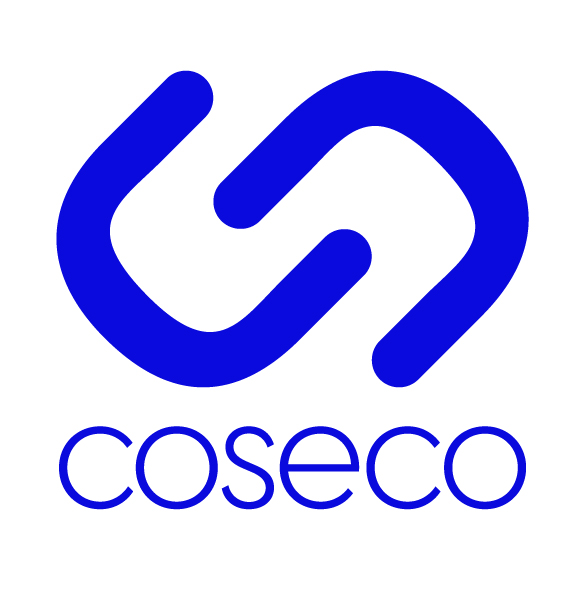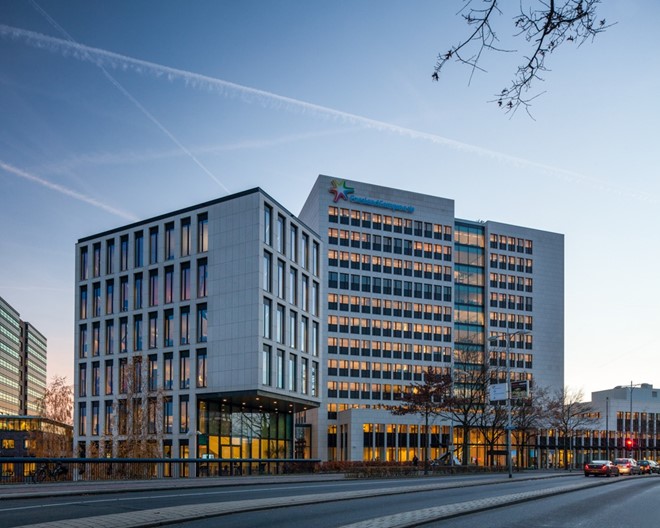From Forehead to elbow: How problems become solutions.
Coseco has had the pleasure of being able to work on making Friesland Campina a safe working environment. Friesland Campina is a multinational dairy Cooperative based in Amersfoort, The Netherlands. The merge of two companies creating Friesland Campina in December of 2008.
Coseco’s partnership with Friesland Campina started with the intention of adding Coseco’s hygiene coach around the entrances of the Friesland Campina’s office building. The job of the hygiene coach was to make sure the temperature of each employee is measured before they were able to enter the work space. Giving everyone peace of mind and a safe working environment.

The hygiene coach functions as follows; the device stands on top of a disinfection pole; it uses infrared sensors and a front camera to detect the forehead temperature of whoever stands in front of the device. After the temperature is measured the 5” or 8” screen tells the person if they are safe to enter the building or not. By June 2020, after many tests done by Coseco and Friesland Campina, the entrances to the office buildings had been fit with the hygiene coach.
However, around September 2020 employees started recognising an issue. With the company being based in the Netherlands, the likeliness of employee’s biking to work is extremely high; Meaning that around September time when people continued to cycle to work the device was unable to give a correct temperature measurement due to the how cold the forehead would get. Meaning the measurement would only be accurate if those who had biked to work would wait ten minutes before measuring their temperature again. This effected the efficiency of employees entering the building and therefore this needed to be solved. How can we fix this issue to make sure everyone still complies with the regulations set out by the government?
The Challenge at Friesland Campina

This issue brought on a new challenge for Coseco. How will we make sure that the efficiency of employees entering the building stays at the same level. After discussing this issue with Friesland Campina themselves, the objective was clear: Make sure everyone is able to enter no matter the transportation taken to get to work. After this discussion a few ideas arose. A changing of software or a changing of the positioning of the infrared thermometer. The latter was deemed the best move as it would mean a changing of the machines external casing rather than the entire system within each device. However, the question was now “how and what do we measure?”
The answer was simple; move the thermometer to measure the temperature of a different part of the body. One that was not as likely to be affected by the outside elements. Coseco then came up with two options; The inside of the mouth or the elbow pit.
Coseco’s Approach:
Coseco then decided to run with this solution and focus on the idea of measuring the temperature of the elbow pit. With this the following had to be done:
- A change to the placing of the Infrared thermometer
- A change in the software adapting to this external change
Coseco then did the following to comply to these new changes. We started by looking at the machine and where to place the Infrared thermometer. We decided to take the top compartment and place it at the bottom of the device. This would ensure a comfortable reach for anyone using the device to measure the temperature of the elbow pit. The software was then also changed to keep this into account.
We fixed and fully converted each device within three weeks. This was done by physically sawing the part now meant for the bottom of the device and placing it on the bottom end. This caused for an interesting learning curve for Coseco; as it helped us become more aware of the environmental effects the could enhance/diminish the productivity of our devices.
The results:
Before the changes were made; On a cold day, around 20% to 30% of the employees had to acclimatise first before a correct measurement could be taken. After this change it was less than
5%. Since the accuracy of the measurement also improved with this update it meant that not only less than 5% had to acclimatise, but that the measurement speed also increased.
This added to a couple of other solutions; the need for employees helping operate the system was eradicated and therefore, the cost of maintenance also decreased. The changes also helped:
- Savings in costs, time and labour
- An acclimatisation rate of less then 5%
- A better accuracy in temperature measurements
- An overall more efficient entering process.
- Less contact between employees meaning a safer environment and process all round.
After having spoken to Friesland Campina it was clear that this was the best solution for the problem at hand. Friesland Campina saying “we asked coseco, and the problem was efficiently tackled. Not an easy change, but they made it happen. And we are satisfied.”
We as a company are extremely proud of the collaboration between Friesland Campina and Coseco to solve this problem. Creating an open dialogue between us and our costumers is extremely important to us, and having been able to solve this problem has helped us re-evaluate the use of our products and how to make them as efficient as possible for this strange and troubling time.

